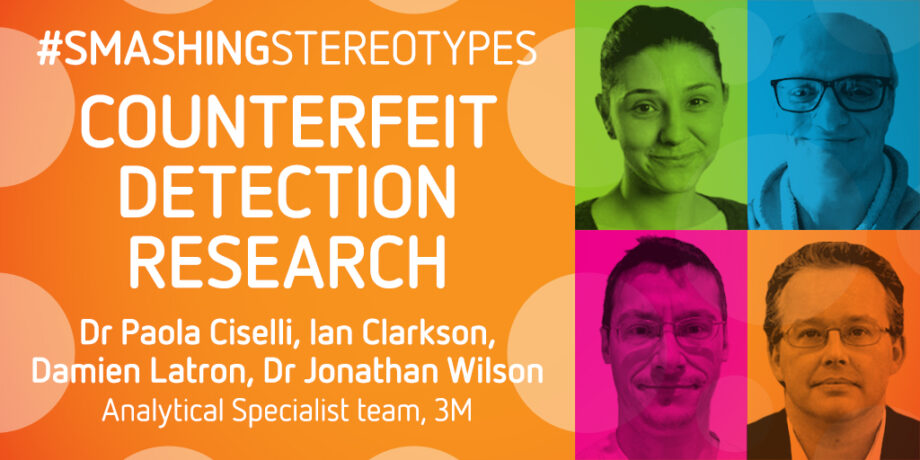3M scientists have created a game-changing new way to detect fake disposable respirators by analysing their unique fingerprint
Dr Paola Ciselli, Ian Clarkson, Damien Latron and Dr Jonathan Wilson
Analytical Specialist team, 3M*
Forgery is on the rise and it’s estimated that nearly half a trillion dollars’ worth of counterfeit products are sold every year.
Not only can this damage the reputation of a company as fake products are often low quality, but they can be harmful. This is particularly true if the product – such as a disposable respirator used by front line health care workers – is designed to protect the wearer from hazards.
The new-to-the-world testing system developed by 3M analytical specialists Dr Paola Ciselli, Ian Clarkson, Damien Latron and Dr Jonathan Wilson is a sophisticated method of scanning products to analyse their unique make-up.
It uses infrared spectroscopy, a scientific method of studying and identifying chemical substances, combined with chemometrics, the science of extracting information from chemical systems using data. In addition, a special software tool was added to help verify the findings.
Paola, Ian, Damien and Jonathan all work for 3M’s Corporate Research Analytical Laboratory, based in Bracknell, Berkshire.
Close collaboration and creative thinking was needed for them to come up with a solution to help 3M stay ahead of counterfeiters.
Paola studied chemistry in her home country, Italy, before moving to the UK to take a PhD, or doctoral research degree, in Nanocomposites: She says: “The problems we face are often unique, so we need to take an open view to come up with the right solution. We started this project before COVID-19 came along, but the pandemic accelerated it.”
Ian, who studied chemistry at university in the UK and in the US, adds: “Our team meetings are deliberately unstructured as it’s how we come up with our best ideas.
“For this project – that felt like a race to beat the counterfeiters – I helped Paola with the data analysis, which was quite complex.”
Data collection was another key element of the project, says Jonathan: “After a lot of discussion, we chose an approach that most analytical labs would be able to follow.”
Jonathan has always been curious about how things work and his path into STEM started at school with a keen interest in chemistry and biology, as well as electronics.
He says: “I discovered there was more to chemistry than bangs and flashes. I had a natural aptitude for the subject and studied it at university. Since then, I have worked in several fields, using analytical chemistry to understand real life problems.”
Damien, who grew up in France and Saudi Arabia and moved to the UK to study chemistry at university, also worked on the collection of data to build the model.
He loves to carry out science projects at home with his three children, such as 3D printing and coding, and has developed fun science experiments to entertain school parties visiting the 3M office.
Damien says: “It’s always a refreshing experience to see first-hand the reaction of young people when demonstrating the unusual properties of some of our everyday materials.”
Initial studies carried out by the team have shown that the new model is able to identify even high-quality counterfeit products with a very high level of accuracy, so it could be used in court cases as legal evidence.
—
Click here to go back to view more scientists who are Smashing Stereotypes.
*The information featured in this profile was last updated in March 2021.
The Smashing Stereotypes campaign is supported by 3M.
